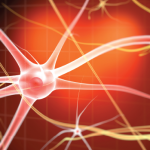“If the brain thinks something is wrong, it turns up sensitivity to protect us from missing something,” Dr. Chiaramonte said. “I give my patients the example of a smoke alarm that’s dysfunctional. If your smoke alarm goes off every time you cook, that’s not helpful. It’s also not helpful if it never goes off. [The alarm] has to be tuned properly so it allows you to cook but alerts you to a fire if one is present.”
In summary, central sensitization plus negative cognitions (e.g., catastrophizing, fear of pain and hypervigilance) lead to pain amplification and increasing disability. Dr. Chiaramonte concluded, “This is the key thing we need to teach our patients about: the role the brain plays in increasing or decreasing pain.”
Pain is more than nociception, the process by which painful stimuli are communicated through the peripheral and central nervous system. Pain is affected by emotions, genetics & the context of a person’s life.
Tools for Managing Pain
Dr. Chiaramonte discussed a multifaceted approach to pain management. “Pain management is more than just medications,” she said. “If you just stick with meds, most of these people won’t get better. Procedures, topicals, mind-body techniques, manual therapies, acupuncture, counseling and behavioral interventions are in your toolbox, too.”
Mind-body techniques, such as meditation, guided imagery, biofeedback, yoga and tai chi can play a role in chronic pain management. “These [options] are super cheap and super safe, so they’re definitely worth exploring,” Dr. Chiaramonte said. “The best option is the one the patient will actually do.”
Example: Both guided imagery and tai chi have been shown to improve fibromyalgia symptoms.2,3 Tai chi has also been shown to improve pain and physical function in those with knee, hip and hand osteoarthritis, as well as rheumatoid arthritis.4
For the patient who is extremely motivated, mindfulness-based stress reduction can be particularly helpful. Mindfulness-based stress reduction is a standardized program developed to reduce suffering for people with chronic pain. It’s an eight-week group experience that involves a seven-hour retreat, 2.5-hour sessions weekly and home practice for 45 minutes daily. The program costs vary.5
“There’s lots of evidence for benefit of [mindfulness-based stress reduction] in pain, anxiety, depression, sleep, health-related quality of life and perceived stress,” Dr. Chiaramonte said. “It was even shown to help adults with chronic low back pain.”5
When it comes to medications, Dr. Chiaramonte highlighted the potential value of intravenous ketamine for patients for whom common therapies, such as antidepressants, antiepileptics and opiates, proved ineffective. Consensus guidelines on the use of intravenous ketamine for chronic pain cite evidence in support of its use, but higher quality, larger, controlled trials are needed.6

